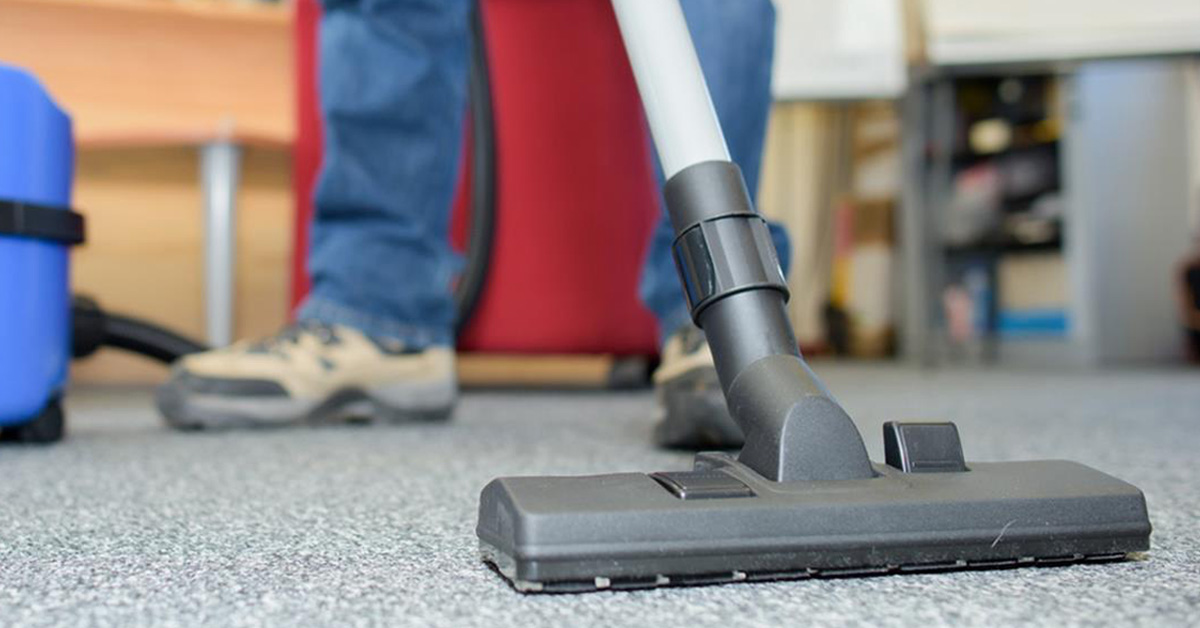A vacuum is an important piece of equipment to have in your supply closet, as it contributes to cleaner carpet and healthier environments. In fact, regular vacuuming removes 80-90% of dry soil accumulation. With a variety of manufacturers and a seemingly endless number of models available on the market, you may be overwhelmed when selecting a new vacuum for your facility.
And once the machine has been purchased, there are still the questions of how and when to vacuum. To protect the appearance of carpet, and the investment you’ve made in it, it’s necessary to select the right equipment and follow best practices.
Selecting the Right Equipment
Vacuums are not a one-size-fits-all solution. While upright vacuums are commonly used in many facilities, there are other designs available. These include backpack vacuums that employees wear and carry around, canister vacuums that collect dirt and debris in a rolling tub that connects to a hose and even ride-on vacuums that are ideal for facilities with lots of carpeted square footage.
With numerous types of vacuums sold and new models released each year, it can be difficult to know if the vacuum you select has the right features, is well-suited to the carpet in your facility and will be easy and ergonomic for employees to use.
To simplify the process, confirm the following features when investing in a new vacuum.
Certification
The Carpet and Rug Institute (CRI) operates a Seal of Approval program for vacuums and awards Bronze, Silver and Gold ratings depending on test results. The CRI tests both general-purpose vacuums and those that are for use on carpet with low pile. Look for the certification symbol so that you know your vacuum model meets strict standards for soil removal, particulate containment and appearance retention. To make the buying process easier, the CRI website maintains a list of approved vacuum cleaners.
Compatibility
It’s important to choose equipment suited to your carpet, your facility and your employees. Take into consideration the carpet profile, density and fiber type. Analyze the width of your carpeted areas and any obstacles that may make it difficult to use ride-on or wide-area machines. Consider your storage space as well. You may prefer a compact model over one that will require more space. Finally, think about the needs of the people who will be operating the vacuums and seek feedback from them.
Soil removal and dust containment capabilities
Today’s vacuums have many features to entice buyers. However, at the end of the day, the vacuum must be able to effectively remove and contain dirt and dust. Not even noise-reduction and ergonomic features can offset poor performance. Look for a vacuum with HEPA filtration, disposable bags, high airflow, durability and commercial performance to ensure it can adequately penetrate carpet fibers and remove contaminants.
If you’d like additional support during the purchase process, your carpet manufacturer may also be able to provide recommendations regarding vacuum types, features and models that are well-matched for your flooring. Careful consideration during this phase ensures that you’ll have better performing vacuums in your arsenal that help protect carpet and keep it looking its best.
Best Practices for Vacuuming
Proper vacuuming methods ensure effective carpet care, save time and reduce labor costs. Make sure that employees responsible for vacuuming adhere to the following best practices:
- Establish vacuuming schedules according to traffic patterns, weather conditions and facility use. Certain areas like entryways may need daily vacuuming while less-trafficked areas can be vacuumed a few times per week to save time without sacrificing image.
- During vacuuming, roller brushes and non-electrical suction wands with brush strips open tufts, agitate and loosen soil. Use a slow pass to allow time for additional airflow to remove embedded soil.
- Remember to combine forward and backward passes to make sure you capture soil from every angle.
- You may be inclined to completely fill the disposable vacuum bag, but it actually needs replacing when it is half full. When a vacuum bag is over half full, 80% of efficiency is lost.
- Vacuums are an investment and proper maintenance helps them last longer. Periodically check brushes and belts for wear and replace these as needed.
A Process for Cleaner Carpet
Daily vacuuming, or at the very least, vacuuming several times per week, helps protect carpet. Even if it doesn’t appear soiled to the naked eye, carpet likely has dirt embedded in its fibers or even on the surface that can be removed through vacuuming. By following the above best practices regarding vacuum selection, training and equipment care, you can maximize soil removal and keep the machine in good working condition over time.

